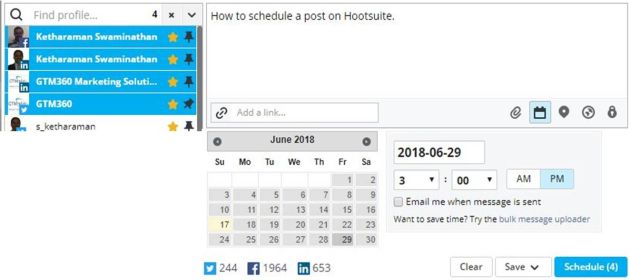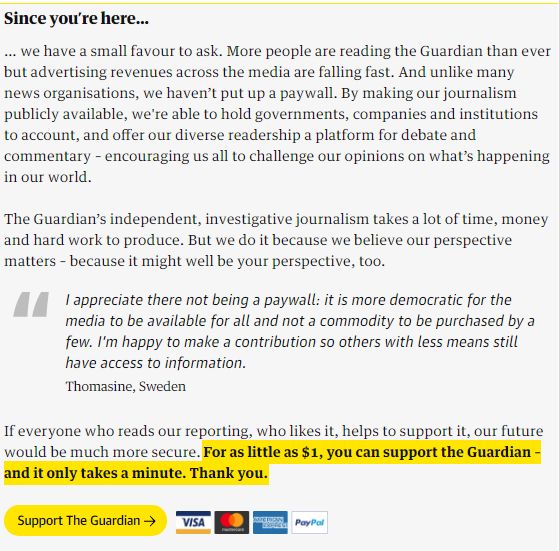To generate rapid traction for their products, many SAAS providers offer a Freemium plan, which is free access to a truncated version of their full blown software.
By doing so, they expect users to sign up for their software without any risk, play around with it for a month or two, and upgrade to the paid version soon thereafter.
Alas, it rarely works like this in the real world. In fact, I call it the modern day version of the old misconception “Build and they will come”.
I’ve been using many products for years without paying for them e.g. CamScanner, Color Detector, Hootsuite, IrfanView, OneTab, Pixel Ruler, WordPress, etc. I’ve heard of people who stretch trial periods of software to eternity by signing up for a new trial version from a different email address when the previous trial version reaches its expiration date.
And it’s not just my personal experience.
According to anecdotal evidence, paid users comprise only 5% of the customer base of most SAAS vendors, with the remaining 95% staying on the freeemium version forever.
It’s not sustainable for most companies to support 100% of their user base with revenues from only 5% of it.
Therefore SAAS vendors are constantly on the look out for ways to convert freemium to premium i.e. upgrade their freemium users to paying customers. Success or failure in this endeavor – more than anything else – separates SAAS unicorns from the deadpool.
FlightRadarPro is the poster child for freemium model: I went from the free app to its paid version in < 10 minutes.
— S.Ketharaman (@s_ketharaman) September 10, 2013
In this two part blog post, I’ll share six best practices for SAAS vendors to convert freemium to premium.
#1. ASK FOR MONEY
I haven’t paid anything for many of the aforementioned products for the simple reason that they never asked me to pay anything. Had they asked, I’d have paid.
The British publisher The Guardian does ask – by inserting a Since you’re here banner at the end of every article.
Some cultures might frown down upon the act of asking for money openly but, from personal experience, I can tell you that this approach works – I’ve donated at least thrice to The Guardian in the last one year.
#2. CREATE PINCH POINTS
Here you create a pinch point for a key feature in your freemium version that can be sidestepped by going premium.
Let me use Hootsuite to illustrate this tactic.
As I’m sure you’d be aware, Twitter, LinkedIn and Facebook don’t allow you to schedule posts (with the exception of Facebook Company Page). This is a major pain area for content and social media marketers who need to maintain a consistent frequency of posting but might lack the time and / or creative juice to bat out copy at each one of those specified dates and times.
By offering the ability to schedule posts into the future, Hootsuite alleviates this pain.

Apart from its basic “write once, post many” paradigm, I signed up for Hootsuite because of its support for Scheduled Posts. At the time, Hootsuite did not specify how many posts could be scheduled in any of its plans. In practice, freemium users found that they could schedule unlimited number of messages. Which was a great thing.
Then, suddenly, Hootsuite introduced a limit of 30 Scheduled Messages (new name for Scheduled Posts) on the freemium version.
Thirty is a woefully small number for most digital marketing professionals who tend to schedule hundreds of posts – my current count stands at 363. So the limit of 30 scheduled messages caused a “pinch point” and drove many freemium users to upgrade to the paid version of Hootsuite (which has no limit on the number of scheduled messages).
For SAAS vendors who’re a bit queasy with this tactic, it’s not as though Hootsuite originally committed unlimited scheduled posts and then reneged on that promise by capping the free limit to 30 messages. By not quantifying the feature originally, Hootsuite left a “placeholder”, which it now filled by putting the figure of 30. Secondly, Hootsuite is now informing new users upfront that the freemium version will allow only 30 scheduled messages. Therefore, I don’t see anything unethical about this approach.
#3. DRIVE ENHANCED USAGE
Sometimes, the pent up pain areas addressed by SAAS products can be resolved by the free trial version of the software, so users fail to upgrade to paid version. In these cases, it’s important to find ways to enhance usage, so that users have a strong case to continue to use the product by upgrading to the paid version after the free trial expires.
We used this tactic for a US SAAS provider of A/B testing solutions. Click here for more details.
In Part 2, I’ll cover three more best practices to help SAAS providers to upgrade their freemium users to paying customers. Watch this space!
